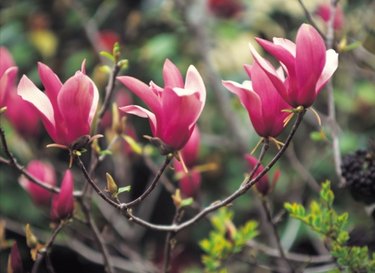
The genus Magnolia includes between 80 and 110 species of deciduous and evergreen trees and shrubs that are native to woodlands and sunny riverbanks in eastern Asia and North and South America. Gardeners grow magnolias primarily for their showy and rather large, fragrant flowers that occur in spring or summer. Of all the magnolia species and cultivars extant today, a plant may be successfully grown in any U.S. Department of Agriculture plant hardiness zone 4 through 12. Magnolias need more sun than shade.
General Growth Requirements
Video of the Day
Grow magnolia plants in a wide array of light exposures, from full sun to partial shade. The general guideline is more sun than shade. Regardless of magnolia species, the ideal growing conditions involve moist, well-drained soil that is rich in organic matter. The soil pH must range from acidic to neutral, as alkaline soils cause severe nutrient deficiencies that stunt growth or weaken magnolias. A few species tolerate slightly alkaline soils, but only if the soil isn't too dry.
Video of the Day
Garden Axiom
A colloquial American gardening axiom regarding magnolias is "keep a magnolia's face in the sun, but its feet in the shade." In other words, let the leafy branches bask in sunlight, but keep their roots cool and moist in shady conditions. A mature magnolia naturally shades its roots. Direct sun rays hitting the branches promotes abundant flowering as well as healthy leaves that photosynthesize light to fuel growth. Magnolia roots generally grow close to the soil surface and thus endure quick changes in soil temperature and drying soil. A shaded soil prevents this fluctuating, exposed vulnerability.
Shade Insight
Magnolia trees and shrubs are not good to plant in dry soils or where arid, drying winds occur in any season. Planting a magnolia in a wind-protected spot can diminish drying winds and provide light shade for part of the day. Placing a 3- to 4-inch mulch layer broadly over the magnolia's root zone shades the soil to keep it cool and moist, especially in the heat of summer. In fast-draining soils or where irrigation isn't available, the need for a mulch soil covering is vital, as it conserves moisture. If the soil is rich, evenly moist and readily irrigated, a magnolia can grow perfectly in all-day sunshine.
Regional Advice for the South
In the southern half of the United States, the summers are long and markedly hotter than in the cooler areas farther north. In hot-summer regions, plant magnolias in partial sun -- receiving 6 to 8 hours of direct sunlight daily. Morning sun exposure followed by shade during the hottest part of the afternoon is best. In northern regions or in higher elevations with cooler summers, a magnolia may handle full sun without drying out. Avoid planting magnolias in overly shady locations, as it causes scrawny branches, fewer leaves and scarce flowering.